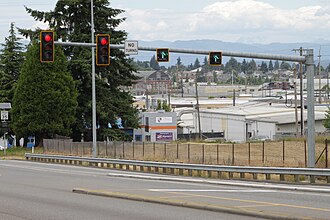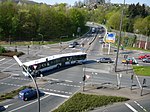Seagull Intersection

A traffic junction of the Seagull type , the English word for "seagull", is a three-armed, T-shaped, level traffic junction that connects the traffic direction opposite the junction with a left connection without conflict. It has different names around the world: in Australia and New Zealand Seagull Intersection , generally in the USA Continuous Green T-Intersection (CGT) , in the US states Utah and Nevada High-T Intersection , in Florida Turbo-T . The construction is particularly suitable for motorway-like roads that run in separate directional lanes and are not free of heights. In urban areas, non-motorized traffic is the only exception to conflict-free traffic management on the continuously green driving lane. This is therefore called Continuous Green Through Lane (CGTL) .
power
Depending on the volume of traffic, the permitted speeds and the clarity of the traffic, the Seagull Intersection does not necessarily require a traffic light. Jammed at locations of traffic lights and on the directions alternately occurring vehicle groups a seagull intersection resolves the conflict that the left-bending in both directions must be free and provides a longer window for tailgating.
In the case of alternating three-armed traffic nodes, so-called offset T intersections , which make a green wave difficult due to the unfavorable distance, the property of the free flowing main direction compared to the lateral direction can be helpful. This saves fuel and emissions.
Executions
The connection on the left requires a limited speed in order to enable the approaching vehicles to be threaded. Since the right driving to stop to use the right lane and the main direction not from traffic signal is controlled and is a priority, it requires at least one road marking , which keeps through traffic from the acceleration lane and prohibits the colliding traffic premature lane change. Unfamiliar markings can be overlooked on snowy roads or when visibility is poor. There are some traffic hubs of this type that safely separate the lanes with traffic islands.
Examples
Germany
- Hauptstrasse (L23) / Bundesstrasse 51 in Olzheim 50 ° 16 ′ 5 ″ N , 6 ° 27 ′ 21 ″ E
- Hauptstrasse (L204) / Bundesstrasse 51 in Dahlem (Northern Eifel) 50 ° 24 ′ 21 ″ N , 6 ° 34 ′ 5 ″ E
- At the Greven junction of the A 1 , the two nodes on the B 481 feeder are designed with lanes instead of restricted areas . 52 ° 5 '0' N , 7 ° 38 '42 " O , 52 ° 5' 5" N , 7 ° 38 '35 " O .
- Verlautenheidener Straße (L23) at the Würselen junction of the A 544 50 ° 48 ′ 4 ″ N , 6 ° 9 ′ 0 ″ E
- On Friederikenplatz in Hannover from Friedrichswall to Leibnizufer 52 ° 22 '11 " N , 9 ° 43' 56" O .
Austria and Hungary
In Austria and Hungary, since the 1980s, restricted areas or similar have increasingly been dispensed with. The area behind the left- turning lane has only been provided with arrows, prompting you to merge to the right in order to announce the following narrowing of the lane to the usual profile. There is often no protective road marking. Some more heavily used traffic hubs are provided with a longer and separating marked lane. The § 7 para. 4 of the Austrian Highway Code (StVO) from 1 October 1994 refers spongy to comparable situations.
Poland
- aleja Młodzieży Polskiej / Kościuszki, Słubice 52 ° 20 ′ 56 ″ N , 14 ° 33 ′ 45 ″ E
Canada
- In Delta, British Columbia at 72 Street on British Columbia Highway 91 49 ° 8 ′ 2 ″ N , 122 ° 55 ′ 44 ″ W
Completed in Saskatoon in 2011:
- on College Drive to Central Avenue 52 ° 7 ′ 43 ″ N , 106 ° 35 ′ 57 ″ W.
- on Circle Drive to Airport Drive 52 ° 9 ′ 17 ″ N , 106 ° 40 ′ 54 ″ W
- on Circle Drive to Laurier Drive 52 ° 8 ′ 4 ″ N , 106 ° 43 ′ 4 ″ W
- on Circle Drive to Clancy Drive 52 ° 7 ′ 19 ″ N , 106 ° 43 ′ 5 ″ W
- on 22nd Street to Hart Road 52 ° 7 ′ 46 ″ N , 106 ° 44 ′ 21 ″ W.
United States
Florida
- In Jacksonville along Roosevelt Boulevard and Main Street (both part of US-17) are 7 GCTLs, opened between 1972 and 1992
- 30 ° 16 ′ 19 ″ N , 81 ° 42 ′ 52 ″ W Ortega Forest Drive, opened March 3, 1987
- 30 ° 16 ′ 43 ″ N , 81 ° 43 ′ 13 ″ W Parking lot for Roosevelt Mall, opened October 13, 1986
- 30 ° 17 ′ 40 ″ N , 81 ° 43 ′ 12 ″ W Park Street
- 30 ° 15 ′ 12 ″ N , 81 ° 41 ′ 57 ″ W Long Bow Road, opened May 1, 1972
- 30 ° 25 ′ 12 ″ N , 81 ° 38 ′ 54 ″ W Imeson Park Boulevard, opened May 17, 1992
- 30 ° 26 ′ 29 ″ N , 81 ° 38 ′ 28 ″ W Baisden Road, opened February 1, 1991
- 30 ° 24 ′ 18 ″ N , 81 ° 38 ′ 59 ″ W Heckscher Drive, opened February 1, 1987
Colorado
- SH-141 / US-50, Grand Junction 39 ° 0 ′ 52 " N , 108 ° 28 ′ 29" W.
- US-160 / US-550 Durango 37 ° 13 '18 " N , 107 ° 50' 47" W.
Nevada
- Lakeshore Road / Great Basin Highway (US-93) Boulder City 36 ° 0 ′ 33 ″ N , 114 ° 48 ′ 0 ″ W
- Lake Mountain Drive / Great Basin Highway (US-93) Boulder City 35 ° 59 ′ 17 ″ N , 114 ° 50 ′ 3 ″ W
Texas
- Allen Parkway / Taft Street - Houston , Texas 29 ° 45 ′ 40 ″ N , 95 ° 23 ′ 9 ″ W
- Lark Boulevard / North Bicentennial Boulevard, McAllen 26 ° 15 ′ 39 ″ N , 98 ° 13 ′ 47 ″ W.
- On the feeder (South 1st Street) to the Winters Freeway (US-277) in Abilene, the two nodes of the half-leaf clover are built as a Continuous-Green-T. Three out of four main directions of the node have free flowing traffic as a result. 32 ° 27 ′ 8 ″ N , 99 ° 47 ′ 6 ″ W.
Utah
Australia
- Cotter Road / Streeton Drive in Weston Creek (near Canberra ) 35 ° 19 ′ 34 ″ S , 149 ° 3 ′ 13 ″ E
- Island Point Road, Tomerong 35 ° 4 ′ 17 ″ S , 150 ° 34 ′ 14 ″ E
- Kells Road, Tomerong 35 ° 3 ′ 55 ″ S , 150 ° 34 ′ 23 ″ E
New Zealand
- Forrest Hill Road / Wairau Road, Takapuna, Auckland 36 ° 46 ′ 48 ″ S , 174 ° 45 ′ 0 ″ E
- Upper Harbor Highway (State Highway 18) / Paul Matthews Drive - North Shore, Auckland 36 ° 45 ′ 9 ″ S , 174 ° 42 ′ 57 ″ E
- New Zealand State Highway 2 / Gibbons Street - Upper Hutt 41 ° 6 ′ 58 ″ S , 175 ° 3 ′ 55 ″ E
- Western Hutt Road (SH 2) / River Road (SH 2) / Fergusson Drive - Silverstream, Upper Hutt 41 ° 8 ′ 42 ″ S , 174 ° 59 ′ 47 ″ E
- New Zealand State Highway 1 / Whitford Brown Drive - Porirua 41 ° 7 ′ 15 ″ S , 174 ° 51 ′ 15 ″ E
- On the Waikato Expressway at 37 ° 19 ′ 33 ″ S , 175 ° 3 ′ 58 ″ E and 37 ° 18 ′ 33 ″ S , 175 ° 4 ′ 3 ″ E
Examples of other CGTLs
- A 4 , half connection Frechen -Nord: southern feeder junction towards north. 50 ° 55 '43 " N , 6 ° 49' 14" E
Web links
- Animation of the traffic flow ( Memento from February 8, 2012 in the Internet Archive )
- Film showing the traffic flow of the AS Würselen , published on YouTube on February 11, 2014
Individual evidence
- ^ A b John Harper, Wal Smart, Michael de Roos: Seagull Intersection Layout. Island Point Road - A Case Study. ( Memento from May 7, 2013 in the Internet Archive ) (Seagull traffic junction design - a case study; PDF; 318 kB) 2000-2010, accessed on August 29, 2013.
- ^ A b c Federal Highway Administration: Intersection Safety Case Study - Continuous Green T-Intersections. (PDF; 649 kB) Publication FHWA-SA-09-016 , 1994–2006, accessed on August 29, 2013.
- ^ Utah Department of Transportation: 5400 South Improvements. ( Memento of January 9, 2013 in the Internet Archive ) Retrieved August 30, 2013.
- ^ A b Nevada Department of Transportation: US 93 Improvements - Buchanan Boulevard to the Hoover Dam Interchange. Retrieved August 30, 2013.
- ↑ Jonathan Reid, PE : Unconventional arterial intersection design, management and operations strategies (PDF; 16.1 MB) Parsons Brinckerhoff . July 2004. Archived from the original on November 15, 2015. Info: The archive link was automatically inserted and has not yet been checked. Please check the original and archive link according to the instructions and then remove this notice. Retrieved September 9, 2012.
- ↑ a b Thobias Sando, Deo Chimba, Valerian Kwigizile, Holly Walker: Safety Analysis of Continuous Green Lane Through Intersections. ( Memento of the original from September 3, 2014 in the Internet Archive ) Info: The archive link was inserted automatically and has not yet been checked. Please check the original and archive link according to the instructions and then remove this notice. In: Journal of the Transportation Research Forum. Vol. 50, No. 1, pp. 5-17, 2011.
- ↑ Stephen Litsas, Hesham Rakha: Evaluation of Continuous Green T-Intersections on 2 Isolated Under-Saturated Four-Lane Highways. Transportation Research Board, Washington 2013.
- ↑ University of Maryland, Attap: Unconventional Arterial Intersection Design. Continuous Green-T. ( Memento of February 8, 2012 in the Internet Archive ) On: attap.umd.edu. Retrieved May 30, 2014.
- ↑ SASKATCHEWAN MINISTRY OF HIGHWAYS AND INFRASTRUCTURE: ANNUAL REPORT 10–11. Retrieved December 18, 2013.
- ↑ Edward S. Jarem: Safety and Operational Characteristics of Continuous Green Through Lanes at signalized intersections in Florida. ( Memento of the original from September 3, 2014 in the Internet Archive ) Info: The archive link was inserted automatically and has not yet been checked. Please check the original and archive link according to the instructions and then remove this notice. Lake Mary (Florida) 2004.
- ↑ City of McAllen: Bicentennial & Lark: Continuous Green Intersection. Retrieved August 30, 2013.






